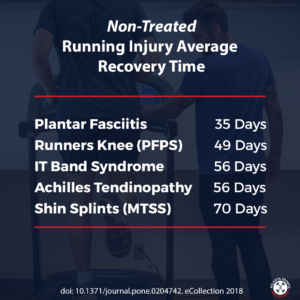Runners get hurt often. According to research, 50% of runners get injured annually. For comparison, the injury rate in CrossFit is 20%, and the public perception of that fitness method is dangerous.
It makes sense. It’s repetitive pounding, and the stress adds up over time, and the soft tissues break down.
Now these are not significant injuries that require surgery. These are the annoying pain in the arse sort of injuries, like plantar fasciitis, that won’t stop you but make life miserable.
Luckily the human body’s soft tissues are impressive super-healing structures. All your muscles, tendons, nerves, fascia, etc. (except for the spinal cord, cartilage, and wholly torn ligaments) will heal with time. How much time?
Well, in the case of running a 2018 study is giving us so hard timelines (see image below).

Yep! So if you have shin splints and continue to run, you can expect it to take around 2.5 months to stop hurting.
These numbers do have a few asterisks
- The runners did not stop running, which slowed things down.
- The runners did not get treated, which helps things heal faster.
- They are average. Everyone heals differently. So you could be faster or slower.
Interesting right? At least it starts answering the question of “how long will this take to heal?”
As a runner and person that specializes in recovery, my takeaways from this article are
- Avoid these over-training injuries by having a good training plan from a professional, which includes cross-training, strength training, and taking time off.
- If I have a soft tissue injury pop-up, GET TREATED IMMEDIATELY.
- Injuries heal, so there is no need to freak out. It’s a matter of time and a mindset shift.
- Look at where I commonly place stress while living and training and plan accordingly if I am overstressing a pattern. Example: If I am sitting at work a bunch and start cycling a ton, I should plan on having tight hip flexors, a sore low back and neck, and start planning to spend time offsetting those risks.

